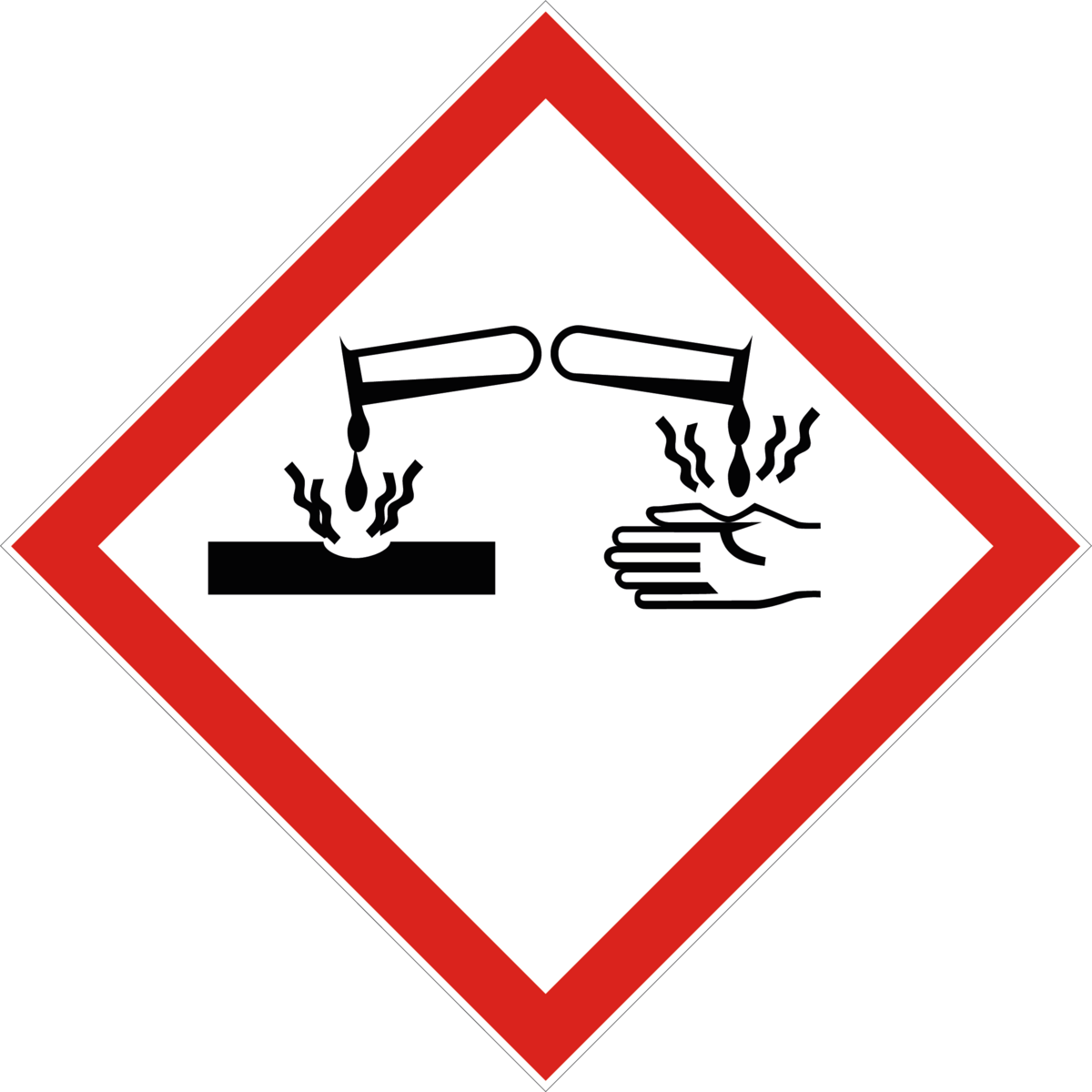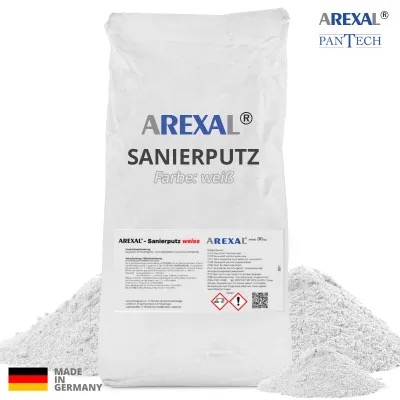€56.76*
Available, delivery time: 2-5 days
Dry mortar for plastering salt-laden, moist interior and exterior walls
Binds the salts in the wall, no efflorescence anymore, no sacrificial plaster!
AREXAL® restoration plaster white is a ready-to-use, white dry mortar according to DIN 18557, mortar group PII according to DIN 18550, for the preparation of a pore-hydrophobic, particularly diffusion-capable plaster for the renovation of old buildings.
Application areas
AREXAL® restoration plaster white is used for the permanent plastering of moist, mostly salt-laden masonry, and is therefore ideally used for the restoration of damp cellars, vaults, and historic building fabric. It achieves dry surfaces and prevents efflorescence and plaster spalling.
AREXAL® restoration plaster white, with its lime content, is suitable for plaster restoration in the area of monument conservation. It is preferably used as an interior restoration plaster in rooms heavily burdened by moisture, and is also optimally suitable in both old and new construction. It balances the room climate and prevents condensation on the plaster surface. It transforms cellar mustiness into living room quality and keeps your walls dry.
AREXAL® restoration plaster white is an essential accompanying measure to any type of horizontal barrier.
Mode of action/Properties:
- AREXAL® restoration plaster white
- is a lime-cement plaster (mortar group PII) with low susceptibility to cracking and a favorable strength ratio
- is a hydrophobic pore plaster with particularly high water vapor diffusion
- is almost capillary inactive, thus does not transport water or salts
- thereby creates a salt-free and dry surface (dew point relocation) inward, prevents condensation)
- permanently prevents salt efflorescence, color and plaster spalling, is absolutely frost and salt resistant, promotes the drying of moist, salt-laden structures
- is not a dehumidifying plaster
- is very suitable for machine processing (plaster machine).
Certificates
Test report No. 958/94 Dr. Böttcher/ Hamburg, Laboratory for Building Materials
| Requirements | ||
| Fresh Mortar | ||
| Consistency | 15.3 | 17.0+0.5cm |
| Bulk Density | 1.36 kg/l | none |
| Air Void Content | 25.5 Vol% | >25 Vol% |
| Water Retention Capacity | 97.75% | 85% |
| Workability | 1.7 cm | < 3 cm |
| Hardened Mortar | ||
| Bulk Density | 1.33 kg/l | 1.40 kg/l |
| Water Vapor Diffusion | 9.5 | < 12 |
| Compressive Strength | 4.9N/mm2 | 1.5-5N/mm2 |
| Ratio: Compressive/Bending Strength | 2.3 | < 3.0 |
| Capillary Water Absorption W24 | 0.8kg/m2 | 0.3 kg/m2 |
| Water Penetration Depth after 24 Hours | 2 mm | < 5 mm |
| Porosity | 49.8 Vol% | > 40Vol% |
| Salt Resistance | passed | passed |
| Storage | dry, on pallets or wooden racks | |
| Shelf Life | max. 6 months | |
| Delivery Form | 30 kg bag | |
| Quality Monitoring | External monitoring possible; self-monitoring by IPA laboratory |
Technical Data
| Material Base | mineral binders, quartz sands |
| Appearance | white |
| Processing Time | 25-40 minutes |
| Processing Temperature | not below 5 degrees (material temperature) |
| Consumption | approx 13 kg/m2 per cm of plaster thickness |
| Minimum Plaster Thickness | 20 mm |
| Thickness cm | Lambda W/mK | Water Vapor Diffusion |
| 2.0 | 0.350 | 8.8 |
| 3.0 | 0.350 | 8.8 |
| 4.0 | 0.350 | 8.8 |
Processing Preliminary Treatment
Remove the existing plaster or bond-disrupting substances down to the raw masonry (up to twice the wall thickness, at least 50 cm beyond the visible moisture limit). Completely eliminate gypsum, wood remnants, and similar foreign materials. Scrape out decayed joint networks to a depth of 2 cm and thoroughly clean the surface (dry blasting) or sweep with a stiff broom. Promptly remove the construction debris while it's still dry.
Salt Treatment
Even with heavily salt-laden building materials, it may be possible to forego any salt treatment if ArexA - pore base plaster is used as a buffer zone.
However, a single salt treatment with ArexA-Pro Concrete or Pro Brick is recommended despite the buffer zone.
- to consolidate the substrate,
- to encapsulate most of the harmful salts in the substrate,
- to increase the lifespan of the pore base plaster and thus the entire restoration system, and
- to ensure its full diffusion capability over this period.
Consumption: at least 0.2 l/m2 per soaking
Spritzbewurf: The spritzbewurf is applied fresh on fresh to the substrate soaked with AREXAL®- Pro Concrete or Brick (waiting time max. 1 hour).
Net-like application is usually done with AREXAL®-restoration plaster white (inside and outside);
To improve the adhesion of all subsequent ArexA - plaster systems, the surface of the bonding bridge should be left spray-rough. The waiting time for the subsequent plaster system is at least 4 hours, usually 2–4 days. If the surface is dry, it should be well pre-moistened.
Base or Leveling Plaster
Uneven plaster bases are leveled with AREXAL®-restoration plaster white. For large irregularities and fissures (20 mm to 60 mm), work in multiple layers. In principle, AREXAL®-restoration plaster white can also act as a leveling plaster, but must not exceed 2 cm plaster thickness (WTA). Only AREXAL® - pore base plaster is suitable as a salt buffer zone, where the minimum layer thickness is 10 mm. Intermediate layers and plaster surface should be left rough.
Before applying further layers or the subsequent restoration plaster, the waiting time should be at least 4 hours. If the surface is dry, it should again be pre-moistened.
Restoration Plaster
Mixing instructions: Pre-place 5 l of clean, cold water in a mixing bucket, sprinkle in the contents of the bag (30 kg), mix intensively and homogeneously in a suitable mixer.
Water consumption with a suitable plaster machine (e.g., G4) is about 220 l/hr.
Mixing Time
Forced-action mixer about 5 minutes. Free-fall mixers are poorly suited and require significantly longer mixing times. To avoid mixing errors, prepare at least one full bag content.
AREXAL® restoration plaster white is usually applied 2–4 days later. For base plaster thicknesses over 2 cm, an additional waiting time of 1 day should be considered (WTA). The restoration plaster mortar is vigorously hand-thrown or processed mechanically. A minimum layer thickness of 2 cm is mandatory.
Exceptions
- over AREXAL® - pore base plaster, 1.5 cm plaster thickness is sufficient
- as a finishing plaster over AREXAL® - barrier plaster, 1 cm plaster thickness is sufficient
AREXAL® restoration plaster white is usually applied in a single layer. High levels of moisture in the substrate or interior restoration of heavily moisture-laden rooms require a two-layer application (minimum plaster thickness per layer 1 cm), as the functionality only begins when the plaster has dried out once.
Intermediate layers should be left rough, as well as the plaster surface if finished with AREXAL® - fine plaster.
Otherwise, after leveling with a straight edge (aluminum) and after setting, the surface is rubbed with a board, preferably without adding water. The waiting time before applying further layers or a subsequent AREXAL® restoration plaster is at least 4 hours.
Notes & Consumption Quantities
- AREXAL® restoration plaster white is processed by hand or mechanically according to the rules of craftsmanship and guidelines for plaster according to DIN 18550; For execution and aftercare of ArexA restoration plaster white, the guidelines for plaster according to DIN 18550 apply: Avoid heat, frost, strong wind during and up to 24 hours after execution, and ensure sufficiently long moistening; For capillary rising dampness, the installation of a horizontal barrier (chemical or mechanical) is recommended as an accompanying measure.
- Protect glass, wood, built-in parts from material contamination
- Clean contaminated parts immediately with plenty of water
- Cleaning of all tools and equipment should also be done immediately after use with water
- Disposal of dried residues through household waste landfill
- 1 bag (30Kg) covers approx. 2.3sqm at 1cm application thickness.
Safety Advice
AREXAL® restoration plaster white is not subject to the Hazardous Substances Regulation (GefStoffV).
However, in a workable state, AREXAL® restoration plaster white is "corrosive" due to its alkalinity.
The prescribed protective measures and accident prevention regulations of the Chemical Professional Association must be strictly followed. In case of contact with eyes, rinse thoroughly with water and consult a doctor. In case of contact with skin, wash immediately with plenty of water. Wear suitable protective clothing, gloves, and eye/face protection during work. Due to its alkaline reaction with water, larger amounts should not enter groundwater or surface water.
Further information is available upon request!
| GHS: |
  |
|---|---|
| Hazard Statements: |
H315 - Causes skin irritation H318 - Causes serious eye damage H373 - May cause damage to organs through prolonged or repeated exposure |
| Precautionary Statements: |
P101: If medical advice is needed, have product container or label at hand. P102: Darf nicht in die Hände vin Kindern gelangen. P264: Wash ... thoroughly after handling. P280: Wear protective gloves/protective clothing/eye protection/face protection. P302+P352: IF ON SKIN: Wash with soap and water. P305+P351+P338: IF IN EYES: Rinse continuously with water for several minutes. Remove contact lenses if present and easy to do. Continue rinsing. P310: Immediately call a POISON CENTER or doctor/physician. P501: Dispose of contents/container to … |
| Purpose: |
indoor outdoor |
| UFI-Nummer: | AY1G-8JJW-N818-HFT6 - Sanierputz weiß |
Produkt Downloads
| Sicherheitsdatenblatt | herunterladen |
Login


